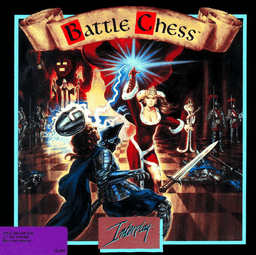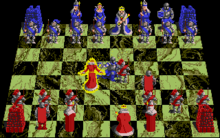
- Chess World Cup
- FIDE Grand Prix
- Olympiad
- World Championship
- List of strong tournaments
- List of world championships

- Checkmate patterns
- Chess openings
- Chess strategy
- Chess tactics
- Chess theory
- Endgames
- Pawn structure
- Problems/Compositions












| Battle Chess | |
|---|---|
 Cover art showing the red queen killing a blue knight |
Publisher(s) | Interplay Entertainment |
| Producer(s) | Brian Fargo |
| Artist(s) | Todd J. Camasta Bruce Schlickbernd |
| Platform(s) | Amiga, 3DO Interactive Multiplayer, Acorn Archimedes, Amiga CD32, Amiga CDTV, Apple IIGS, Apple IIe, Atari ST, Commodore 64, MS-DOS, FM Towns, NES, Mac OS, NEC PC-9801, X68000, Microsoft Windows |
| Release date(s) | 1988-1994 |
| Genre(s) | Chess |
| Mode(s) | Single player, two player |
Battle Chess is a video game version of chess in which the chess pieces come to life and battle one another when capturing. It was originally developed and released by Interplay Entertainment for the Amiga in 1988 and subsequently on many other systems, including 3DO Interactive Multiplayer, Acorn Archimedes, Amiga CD32, Amiga CDTV, Apple IIGS, Apple IIe, Atari ST, Commodore 64, MS-DOS, FM Towns, NES, Mac OS, NEC PC-9801, X68000 and Microsoft Windows. In 1991, Battle Chess Enhanced was released by Interplay for the PC, featuring improved VGA graphics and a symphonic musical score that played from the CD-ROM.
Battle Chess was critically acclaimed and commercially successful, resulting in two official follow-ups as well as several inspired games. Its remake, Battle Chess: Game of Kings, was released on Steam on March 16, 2014.
 Atari ST gameplay screenshot
Atari ST gameplay screenshotSince there are six types of pieces for each color, and a king cannot capture a king, there are 35 battle animations. The rook, for example, turns into a rock monster and kills a pawn by smashing his head. There are some pop-culture homages; the knight versus knight animation references the black knight fight in Monty Python and the Holy Grail , and the king versus bishop fight pastiches the short battle between Indiana Jones and a swordsman in Raiders of the Lost Ark.
The game can be also played in a 2D version with no animations, and the Amiga CDTV version features a fully voiced introduction describing the movements of the pieces for the benefit of beginners. Digitized sound is utilized in the DOS version for all battle sound effects and is played through the PC speaker, without the need for a sound card, using a technique akin to RealSound.
Battle Chess could be played against a human opponent (by hotseat, or by null modem or over a local area network in some ports) or against the computer's artificial intelligence (AI). The game has an opening library from over 30,000 moves (which were not available for the Commodore 64 and Apple II versions).
Battle Chess was the first title developed and published by Interplay Entertainment themselves after ending their relationship with Electronic Arts, besides Neuromancer. The game was featured in the 1992 film Knight Moves about a chess grandmaster who is accused of several murders. Battle Chess producer and Interplay's founder Brian Fargo expressed his fondness for the game in a 2006 interview, although he added that he did not think there would be much of an audience for it today.
An apocryphal story of the development was the invention of "The Duck" (an example of Parkinson's law of triviality): The producers of the game were known to demand changes to the game, presumably to make their mark on the finished product. To this end, one animator added a small duck around the queen piece, but made sure that the sprite would be easily removable. Come review, the producers, predictably, okayed everything but asked for the duck to be removed.
| Reception | ||||||||||||||||
|---|---|---|---|---|---|---|---|---|---|---|---|---|---|---|---|---|
|
||||||||||||||||
The Amiga version received favourable reviews from magazines due its comical battle sequences which were advanced (for the time) in terms of graphics, animation and sound. German game magazine ASM, however, criticized the weak chess AI. In a review of the 3DO version, Electronic Gaming Monthly stated, "If you are a chess fan, then you may want to check this title out."
Interplay won "Best Graphics Achievement In A Non-Graphics Product" from Software Publishers Association (later renamed to Software and Information Industry Association) for Battle Chess. In 1996, Computer Gaming World ranked it as the 106th best game of all time for its "funny, elaborate animated sequences and spectacular special effects."
A sequel titled Battle Chess II: Chinese Chess was released in 1991, based on xiangqi, commonly known as "Chinese chess". The next year's Battle Chess 4000 spoofed science fiction movies and television series (such as a battle sequence involving the monolith from 2001: A Space Odyssey) and used a clay animation art style similar to Clayfighter.
On December 28, 2015, Brian Fargo revealed that he had started working on a second sequel of the game titled Battle Chess 3 in the late 1990s but the game was cancelled. He also releasedd a footage of the prototype of the game.
Battle Chess also spawned a number of inspired games, such as Star Wars Chess, released by Software Toolworks in 1993, Terminator 2: Judgment Day - Chess Wars, developed by Capstone Software and released by IntraCorp also in 1993, and National Lampoon's Chess Maniac 5 Billion and 1. Another clone, War Chess was released by XS Games for the PlayStation 2 in 2005, and was later ported to the PC by Big Fish Games and released online.
One similar game, titled Battle vs. Chess, was developed by TopWare Interactive for "just about every platform". However, Interplay filed and won an injunction for trademark infringement in 2010 and TopWare was prevented from releasing Battle vs Chess in the United States. The District Court of California came into session and given that after two years of litigation, TopWare Interactive discharged their lawyer, resulting in Interplay winning the case by default.
The remake Battle Chess: Game of Kings was released by Interplay on Steam in 2014.